Thermal Contribution of the Local Climate Zone and Its Spatial Distribution Effect on Land Surface Temperature in Different Macroclimate Cities
Abstract
:1. Introduction
2. Materials and Methods
2.1. Study Area
2.2. Methods
2.2.1. Map LCZ and LST
2.2.2. Distinguishing the Cooling and Heating Effects of the LCZ
2.2.3. Quantifying the Spatial Distribution of the Heating/Cooling Effect
2.2.4. Statistical Analysis
3. Results
3.1. LCZ Classification and LST Investigation
3.2. Thermal Contributions of the LCZs
3.3. The Effect of Spatial Distribution
4. Discussion
4.1. Thermal Environments of the LCZs
4.2. Spatial Effects of Heating/Cooling LCZs on LSTs
4.3. Contributions and Limitations
5. Conclusions
Author Contributions
Funding
Data Availability Statement
Acknowledgments
Conflicts of Interest
Appendix A. LCZ and LST Mapping
| City | Scene ID | Acquisition Data | Scene Time (UTC) | Images for LST Retrieval |
|---|---|---|---|---|
| Jinghong | LC81300452019358LGN00 | 2019-12-24 | 03:42 | Winter |
| LC81300452020137LGN00 | 2020-05-16 | 03:41 | Summer | |
| LC81300452019038LGN00 | 2019-02-07 | 03:41 | ||
| Kunming | LC81290432019351LGN00 | 2019-12-17 | 03:35 | Winter |
| LC81290432019127LGN00 | 2019-05-07 | 03:34 | Summer | |
| LC81290432019047LGN00 | 2019-02-16 | 03:34 | ||
| Zhaotong | LC81290412019079LGN00 | 2019-03-20 | 03:33 | |
| LC81290412020130LGN00 | 2020-05-09 | 03:33 | Summer | |
| LC81290412019223LGN00 | 2019-08-11 | 03:34 | ||
| LC81290412019351LGN00 | 2019-12-17 | 03:34 | Winter | |
| Shangri-La | LC81320412019228LGN00 | 2019-08-16 | 03:52 | Summer |
| LC81320412020087LGN00 | 2020-03-27 | 03:52 | ||
| LC81320412020007LGN00 | 2020-01-07 | 03:52 | Winter | |
| Yuanjiang | LC81300442019358LGN00 | 2019-12-24 | 03:41 | Winter |
| LC81300442020073LGN00 | 2020-03-13 | 03:41 | ||
| LC81300442020137LGN00 | 2020-05-16 | 04:40 | Summer |
| LCZs | WUDAPT | Modified Method | ||||||||
|---|---|---|---|---|---|---|---|---|---|---|
| Jinghong | Yuanjiang | Kunming | Zhaotong | Shangri-La | Jinghong | Yuanjiang | Kunming | Zhaotong | Shangri-La | |
| LCZ1 | NA | NA | 40.48 | NA | NA | NA | NA | 57.96 | NA | NA |
| LCZ2 | 73.96 | 62.69 | 57.28 | 60.98 | 75.54 | 82.98 | 91.07 | 61.02 | 74.63 | 90.00 |
| LCZ3 | 73.53 | 69.84 | 64.60 | 64.00 | 73.02 | 79.07 | 73.21 | 74.04 | 83.04 | 74.59 |
| LCZ4 | 73.75 | NA | 49.79 | 80.87 | NA | 78.67 | NA | 64.42 | 90.33 | NA |
| LCZ5 | 71.34 | 82.89 | 45.13 | 89.34 | NA | 78.92 | 97.62 | 56.56 | 99.17 | NA |
| LCZ6 | 71.48 | 66.90 | 65.15 | 64.89 | NA | 78.49 | 77.93 | 58.66 | 64.21 | NA |
| LCZ8 | 89.00 | 59.68 | 79.07 | 92.04 | NA | 95.43 | 61.76 | 78.71 | 95.35 | NA |
| LCZ9 | NA | NA | NA | NA | 89.67 | NA | NA | NA | NA | 98.71 |
| LCZ10 | NA | NA | 85.66 | NA | NA | NA | NA | 89.1 | NA | NA |
| LCZA | 97.61 | 92.46 | 98.68 | 98.42 | 99.42 | 95.86 | 93.33 | 98.38 | 99.08 | 100.00 |
| LCZB | 93.18 | 50.96 | 37.48 | 76.92 | 65.93 | 85.71 | 76.58 | 52.36 | 78.95 | 80.49 |
| LCZC | 72.73 | 98.60 | 73.01 | 58.93 | 91.45 | 91.30 | 96.32 | 70.81 | 53.47 | 94.62 |
| LCZD | 45.95 | 77.65 | 77.83 | 96.10 | 100 | 48.94 | 80.68 | 74.83 | 94.66 | 100.00 |
| LCZF | 97.27 | 90.00 | 59.01 | 64.38 | 89.13 | 98.28 | 89.58 | 62.45 | 73.61 | 97.56 |
| LCZG | 99.13 | 91.13 | 99.94 | 95.83 | 98.64 | 98.55 | 100.00 | 99.99 | 100.00 | 98.65 |
| LCZH | NA | 78.13 | 98.49 | NA | NA | NA | 92.00 | 99.51 | NA | NA |
| Overall accuracy (%) | 85.00 | 81.32 | 90.9 | 81.04 | 86.5 | 0.88 | 89.14 | 92.5 | 85.18 | 91.75 |
| Kappa Coefficient | 0.83 | 0.79 | 0.80 | 0.79 | 0.84 | 0.87 | 0.88 | 0.84 | 0.83 | 0.90 |
Appendix B. Land Surface Temperature and Local Climate Zones

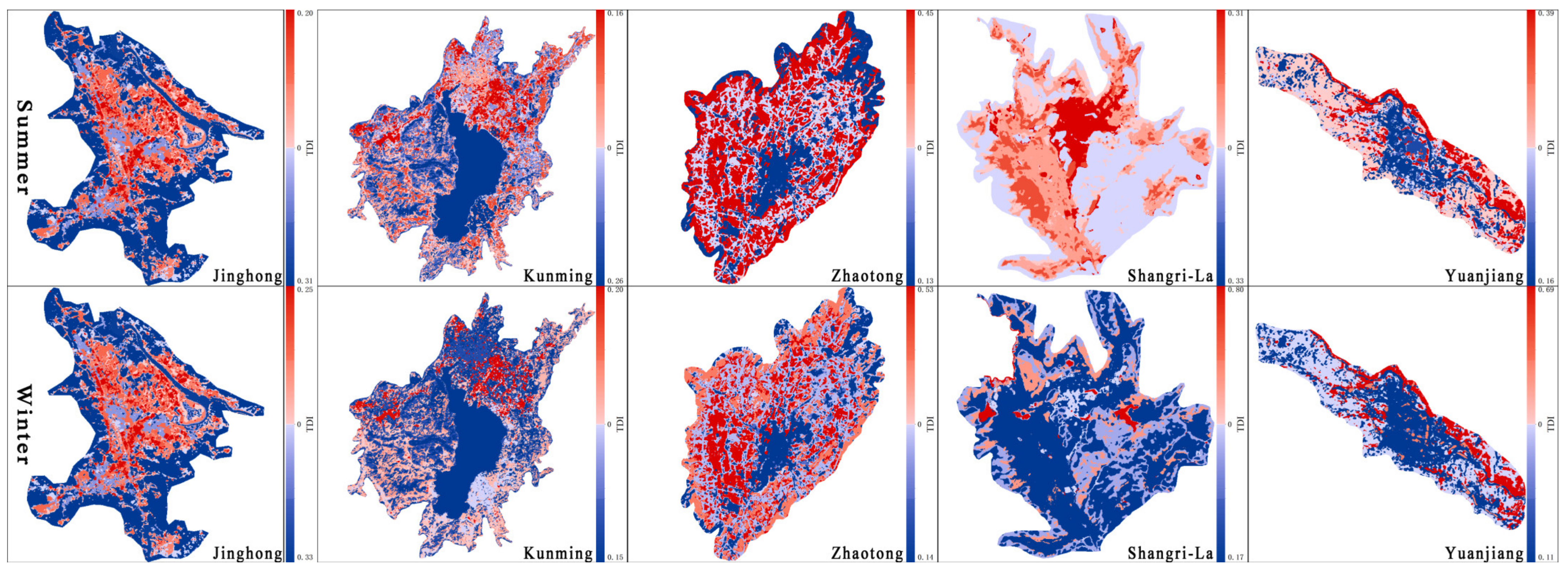

Appendix C. Spatial Regression Validation
| Season | City | Thermal Contribution | Coefficient | Constant | λ | LM | R-Squared | Log-Likelihood | AIC |
|---|---|---|---|---|---|---|---|---|---|
| Summer | JH | Heating LCZs | 13.27 | 33.16 *** | 1.00 *** | 375.64 *** | 0.99 (0.50) | 59,092.98 | −118,178.00 |
| Cooling LCZs | −1.81 | ||||||||
| YJ | Heating LCZs | 1.51 | 49.27 *** | 1.00 *** | 56.75 *** | 0.99 (0.12) | 7909.14 | −15,812.30 | |
| Cooling LCZs | −12.73 | ||||||||
| KM | Heating LCZs | 7.89 | 48.34 *** | 1.00 *** | 39,717.31 *** | 0.99 (0.38) | −159,410.66 | 318,827.00 | |
| Cooling LCZs | −12.73 | ||||||||
| ZT | Heating LCZs | 0.28 | 40.63 *** | 1.00 *** | 6.31 ** | 0.99 (0.20) | 5380.81 | −10,755.60 | |
| Cooling LCZs | −0.19 | ||||||||
| SG | Heating LCZs | 8.58 | 19.93 *** | 1.00 *** | 1240.17 *** | 0.99 (0.58) | 126,248.96 | −252,492.00 | |
| Cooling LCZs | −0.92 | ||||||||
| Winter | JH | Heating LCZs | 9.12 | 33.16 *** | 1.00 *** | 482.91 *** | 0.99 (0.42) | 59,092.98 | −118,178.00 |
| Cooling LCZs | −1.99 | ||||||||
| YJ | Heating LCZs | 0.52 | 49.27 *** | 1.00 *** | 13.43 *** | 0.99 (0.16) | 7909.14 | −15,812.30 | |
| Cooling LCZs | −4.30 | ||||||||
| KM | Heating LCZs | 5.46 | 48.34 *** | 1.00 *** | 30,623.04 *** | 0.99 (0.25) | −159,410.66 | 318,827.00 | |
| Cooling LCZs | −4.72 | ||||||||
| ZT | Heating LCZs | 0.38 | 40.63 *** | 1.00 *** | 6.31 ** | 0.99 (0.37) | 5380.81 | −10,755.60 | |
| Cooling LCZs | −0.42 | ||||||||
| SG | Heating LCZs | 2.39 | 19.93 *** | 1.00 *** | 1240.17 *** | 0.99 (0.33) | 126,248.96 | −252,492.00 | |
| Cooling LCZs | −0.57 |
| Index | Thermal Contribution | Coefficient | Constant | λ | R-Squared | Log-Likelihood | AIC | |
|---|---|---|---|---|---|---|---|---|
| TWGI | Summer | Heating LCZs | 13.27 *** | 33.16 *** | 1.00 *** | 0.99 (0.50) | 59,092.98 | −118,178.00 |
| Cooling LCZs | −1.81 *** | |||||||
| Winter | Heating LCZs | 9.12 *** | 24.51 *** | 1.00 *** | 0.99 (0.42) | 63,098.09 | −126,188.00 | |
| Cooling LCZs | −1.99 *** | |||||||
| GI | Summer | Heating LCZs | 1.36 *** | 33.87 *** | 1.00 *** | 0.99 (0.45) | 58,009.12 | −116,010.00 |
| Cooling LCZs | −0.41 *** | |||||||
| Winter | Heating LCZs | 0.89 *** | 25.70 *** | 1.00 *** | 0.99 (0.41) | 60,165.67 | −120,325.00 | |
| Cooling LCZs | −0.48 *** |
References
- United Nations Department of Economic and Social Affairs. World Urbanization Prospects 2018: Highlights; United Nations: New York, NY, USA, 2019. [Google Scholar] [CrossRef]
- Oke, T.R. The energetic basis of the urban heat island. Q. J. Meteorol. Soc. 1982, 108, 1–24. [Google Scholar] [CrossRef]
- Basara, J.B.; Basara, H.G.; Illston, B.G.; Crawford, K.C. The Impact of the Urban Heat Island during an Intense Heat Wave in Oklahoma City. Adv. Meteorol. 2010, 2010, 230365. [Google Scholar] [CrossRef]
- Roxon, J.; Ulm, F.J.; Pellenq, R.J.M. Urban heat island impact on state residential energy cost and CO2 emissions in the United States. Urban Clim. 2020, 31, 100546. [Google Scholar] [CrossRef]
- Zhou, D.; Xiao, J.; Bonafoni, S.; Berger, C.; Deilami, K.; Zhou, Y.; Frolking, S.; Yao, R.; Qiao, Z.; Sobrino, J. Satellite Remote Sensing of Surface Urban Heat Islands: Progress, Challenges, and Perspectives. Remote. Sens. 2018, 11, 48. [Google Scholar] [CrossRef]
- Marshall, B.; Ezekiel, C.; Gichuki, J.; Mkumbo, O.; Sitoki, L.; Wanda, F. Global warming is reducing thermal stability and mitigating the effects of eutrophication in Lake Victoria (East Africa). Nat. Preced. 2009. [Google Scholar] [CrossRef]
- Deilami, K.; Kamruzzaman, M.; Liu, Y. Urban heat island effect: A systematic review of spatio-temporal factors, data, methods, and mitigation measures. Int. J. Appl. Earth Obs. Geoinf. 2018, 67, 30–42. [Google Scholar] [CrossRef]
- Su, Y.; Wu, J.; Zhang, C.; Wu, X.; Li, Q.; Liu, L.; Bi, C.; Zhang, H.; Lafortezza, R.; Chen, X. Estimating the cooling effect magnitude of urban vegetation in different climate zones using multi-source remote sensing. Urban Clim. 2022, 43, 101155. [Google Scholar] [CrossRef]
- Wang, C.; Wang, Z.-H.; Yang, J. Cooling Effect of Urban Trees on the Built Environment of Contiguous United States. Earth’s Future 2018, 6, 1066–1081. [Google Scholar] [CrossRef]
- Cai, M.; Ren, C.; Xu, Y.; Lau, K.K.-L.; Wang, R. Investigating the relationship between local climate zone and land surface temperature using an improved WUDAPT methodology—A case study of Yangtze River Delta, China. Urban Clim. 2018, 24, 485–502. [Google Scholar] [CrossRef]
- Chen, X.; Xu, Y.; Yang, J.; Wu, Z.; Zhu, H. Remote sensing of urban thermal environments within local climate zones: A case study of two high-density subtropical Chinese cities. Urban Clim. 2020, 31, 100568. [Google Scholar] [CrossRef]
- Nassar, A.K.; Blackburn, G.A.; Whyatt, J.D. Dynamics and controls of urban heat sink and island phenomena in a desert city: Development of a local climate zone scheme using remotely-sensed inputs. Int. J. Appl. Earth Obs. Geoinf. 2016, 51, 76–90. [Google Scholar] [CrossRef]
- Yang, Q.; Huang, X.; Li, J. Assessing the relationship between surface urban heat islands and landscape patterns across climatic zones in China. Sci. Rep. 2017, 7, 9337. [Google Scholar] [CrossRef] [PubMed]
- O′Neill, R.V.; Krummel, J.R.; Gardner, R.H.; Sugihara, G.; Jackson, B.; DeAngelis, D.L.; Milne, B.T.; Turner, M.G.; Zygmunt, B.; Christensen, S.W.; et al. Indices of landscape pattern. Landsc. Ecol. 1988, 1, 153–162. [Google Scholar] [CrossRef]
- Du, H.; Wang, D.; Wang, Y.; Zhao, X.; Qin, F.; Jiang, H.; Cai, Y. Influences of land cover types, meteorological conditions, anthropogenic heat and urban area on surface urban heat island in the Yangtze River Delta Urban Agglomeration. Sci. Total Environ. 2016, 571, 461–470. [Google Scholar] [CrossRef] [PubMed]
- Li, J.; Song, C.; Cao, L.; Zhu, F.; Meng, X.; Wu, J. Impacts of landscape structure on surface urban heat islands: A case study of Shanghai, China. Remote. Sens. Environ. 2011, 115, 3249–3263. [Google Scholar] [CrossRef]
- Zhao, L.; Lee, X.; Smith, R.B.; Oleson, K. Strong contributions of local background climate to urban heat islands. Nature 2014, 511, 216–219. [Google Scholar] [CrossRef] [PubMed]
- Peng, S.-S.; Piao, S.; Zeng, Z.; Ciais, P.; Zhou, L.; Li Laurent, Z.X.; Myneni Ranga, B.; Yin, Y.; Zeng, H. Afforestation in China cools local land surface temperature. Proc. Nat. Acad. Sci. USA 2014, 111, 2915–2919. [Google Scholar] [CrossRef]
- Gunawardena, K.R.; Wells, M.J.; Kershaw, T. Utilising green and bluespace to mitigate urban heat island intensity. Sci. Total Environ. 2017, 584, 1040–1055. [Google Scholar] [CrossRef]
- Wang, Y.; Zhan, Q.; Ouyang, W. How to Quantify the relationship between spatial distribution of urban waterbodies and land surface temperature? Sci. Total Environ. 2019, 671, 1–9. [Google Scholar] [CrossRef]
- Aslam, A.; Rana, I.A. The use of local climate zones in the urban environment: A systematic review of data sources, methods, and themes. Urban Clim. 2022, 42, 101120. [Google Scholar] [CrossRef]
- Oke, T.R.; Mills, G.; Christen, A.; Voogt, J.A. Urban Climates; Cambridge University Press: Cambridge, UK, 2017. [Google Scholar]
- Stewart, I.D.; Oke, T.R.; Krayenhoff, E.S. Evaluation of the ‘local climate zone’ scheme using temperature observations and model simulations. Int. J. Climatol. 2014, 34, 1062–1080. [Google Scholar] [CrossRef]
- Bechtel, B.; Alexander, P.J.; Beck, C.; Böhner, J.; Brousse, O.; Ching, J.; Demuzere, M.; Fonte, C.; Gál, T.; Hidalgo, J.; et al. Generating WUDAPT level 0 data—Current status of production and evaluation. Urban Clim. 2019, 27, 24–45. [Google Scholar] [CrossRef]
- Bechtel, B.; Demuzere, M.; Mills, G.; Zhan, W.; Sismanidis, P.; Small, C.; Voogt, J. SUHI analysis using Local Climate Zones—A comparison of 50 cities. Urban Clim. 2019, 28, 100451. [Google Scholar] [CrossRef]
- Lin, Z.; Xu, H. A Study of urban heat island intensity based on “local climate zones”: A case study in Fuzhou, China. In Proceedings of the 4th International Workshop on Earth Observation and Remote Sensing Applications (EORSA), Guangzhou, China, 4–6 July 2016; pp. 250–254. [Google Scholar] [CrossRef]
- Ochola, E.M.; Fakharizadehshirazi, E.; Adimo, A.O.; Mukundi, J.B.; Wesonga, J.M.; Sodoudi, S. Inter-Local climate zone differentiation of land surface temperatures for management of Urban Heat in Nairobi City, Kenya. Urban Clim. 2020, 31, 100540. [Google Scholar] [CrossRef]
- Shih, W. The impact of urban development patterns on thermal distribution in Taipei. In Proceedings of the 2017 Joint Urban Remote Sensing Event (JURSE), Dubai, United Arab Emirates, 6–8 March 2017; pp. 1–5. [Google Scholar] [CrossRef]
- Wang, C.; Middel, A.; Myint, S.W.; Kaplan, S.; Brazel, A.J.; Lukasczyk, J. Assessing local climate zones in arid cities: The case of Phoenix, Arizona and Las Vegas, Nevada. ISPRS J. Photogr. Remote Sens. 2018, 141, 59–71. [Google Scholar] [CrossRef]
- Zhao, C. Linking the Local Climate Zones and Land Surface Temperature to Investigate the Surface Urban Heat Island, a Case Study of San Antonio, Texas, U.S. ISPRS Ann. Photogr. Remote Sens. Spat. Inf. Sci. 2018, 3, 277–283. [Google Scholar] [CrossRef]
- Zhao, C.; Jensen, J.L.R.; Weng, Q.; Currit, N.; Weaver, R. Use of Local Climate Zones to investigate surface urban heat islands in Texas. GIScience Remote Sens. 2020, 57, 1083–1101. [Google Scholar] [CrossRef]
- Zomer, R.J.; Xu, J.; Wang, M.; Trabucco, A.; Li, Z. Projected impact of climate change on the effectiveness of the existing protected area network for biodiversity conservation within Yunnan province, China. Biol. Conserv. 2015, 184, 335–345. [Google Scholar] [CrossRef]
- Xu, D.; Yun, T.; Chang-chun, D. A fine mesh climate division and the selection of representative climate stations in Yunnan Province. Trans. Atmos. Sci. 2011, 34, 336–342. [Google Scholar]
- Verdonck, M.-L.; Okujeni, A.; Van der Linden, S.; Demuzere, M.; De Wulf, R.; van Coillie, F. Influence of neighbourhood information on ‘Local Climate Zone’ mapping in heterogeneous cities. Int. J. Appl. Earth Obs. Geoinf. 2017, 62, 102–113. [Google Scholar] [CrossRef]
- Stewart, I.D.; Oke, T.R. Local Climate Zones for Urban Temperature Studies. Bull. Am. Meteorol. Soc. 2012, 93, 1879–1900. [Google Scholar] [CrossRef]
- Du, C.; Ren, H.; Qin, Q.; Meng, J.; Zhao, S. A Practical Split-Window Algorithm for Estimating Land Surface Temperature from Landsat 8 Data. Remote Sens. 2015, 7, 647–665. [Google Scholar] [CrossRef]
- Ren, H.; Du, C.; Liu, R.; Qin, Q.; Yan, G.; Li, Z.-L.; Meng, J. Atmospheric water vapor retrieval from Landsat 8 thermal infrared images. J. Geophys. Res. Atmos. 2015, 120, 1723–1738. [Google Scholar] [CrossRef]
- Dai, Z.; Guldmann, J.-M.; Hu, Y. Spatial regression models of park and land-use impacts on the urban heat island in central Beijing. Sci. Total Environ. 2018, 626, 1136–1147. [Google Scholar] [CrossRef]
- Yang, J.; Ren, J.; Sun, D.; Xiao, X.; Xia, J.; Jin, C.; Li, X. Understanding land surface temperature impact factors based on local climate zones. Sustain. Cities Soc. 2021, 69, 102818. [Google Scholar] [CrossRef]
- Yang, J.; Wang, Y.; Xiao, X.; Jin, C.; Xia, J.; Li, X. Spatial differentiation of urban wind and thermal environment in different grid sizes. Urban Clim. 2019, 28, 100458. [Google Scholar] [CrossRef]
- Eldesoky, A.H.M.; Gil, J.; Pont, M.B. The suitability of the urban local climate zone classification scheme for surface temperature studies in distinct macroclimate regions. Urban Clim. 2021, 37, 100823. [Google Scholar] [CrossRef]
- Khoshnoodmotlagh, S.; Daneshi, A.; Gharari, S.; Verrelst, J.; Mirzaei, M.; Omrani, H. Urban morphology detection and it′s linking with land surface temperature: A case study for Tehran Metropolis, Iran. Sustain. Cities Soc. 2021, 74, 103228. [Google Scholar] [CrossRef]
- Du, P.; Chen, J.; Bai, X.; Han, W. Understanding the seasonal variations of land surface temperature in Nanjing urban area based on local climate zone. Urban Clim. 2020, 33, 100657. [Google Scholar] [CrossRef]
- Wetzel, R.G. 6—Fate of Heat. In Limnology, 3rd ed.; Wetzel, R.G., Ed.; Academic Press: San Diego, CA, USA, 2001; pp. 71–92. [Google Scholar]
- Li, D.; Liao, W.; Rigden, A.J.; Liu, X.; Wang, D.; Malyshev, S.; Shevliakova, E. Urban heat island: Aerodynamics or imperviousness? Sci. Adv. 2019, 5, eaau4299. [Google Scholar] [CrossRef]
- Wang, C.; Li, Y.; Myint, S.W.; Zhao, Q.; Wentz, E.A. Impacts of spatial clustering of urban land cover on land surface temperature across Köppen climate zones in the contiguous United States. Landsc. Urban Plan. 2019, 192, 103668. [Google Scholar] [CrossRef]
- Hwang, Y.H.; Lum, Q.J.G.; Chan, Y.K.D. Micro-scale thermal performance of tropical urban parks in Singapore. Build. Environ. 2015, 94, 467–476. [Google Scholar] [CrossRef]
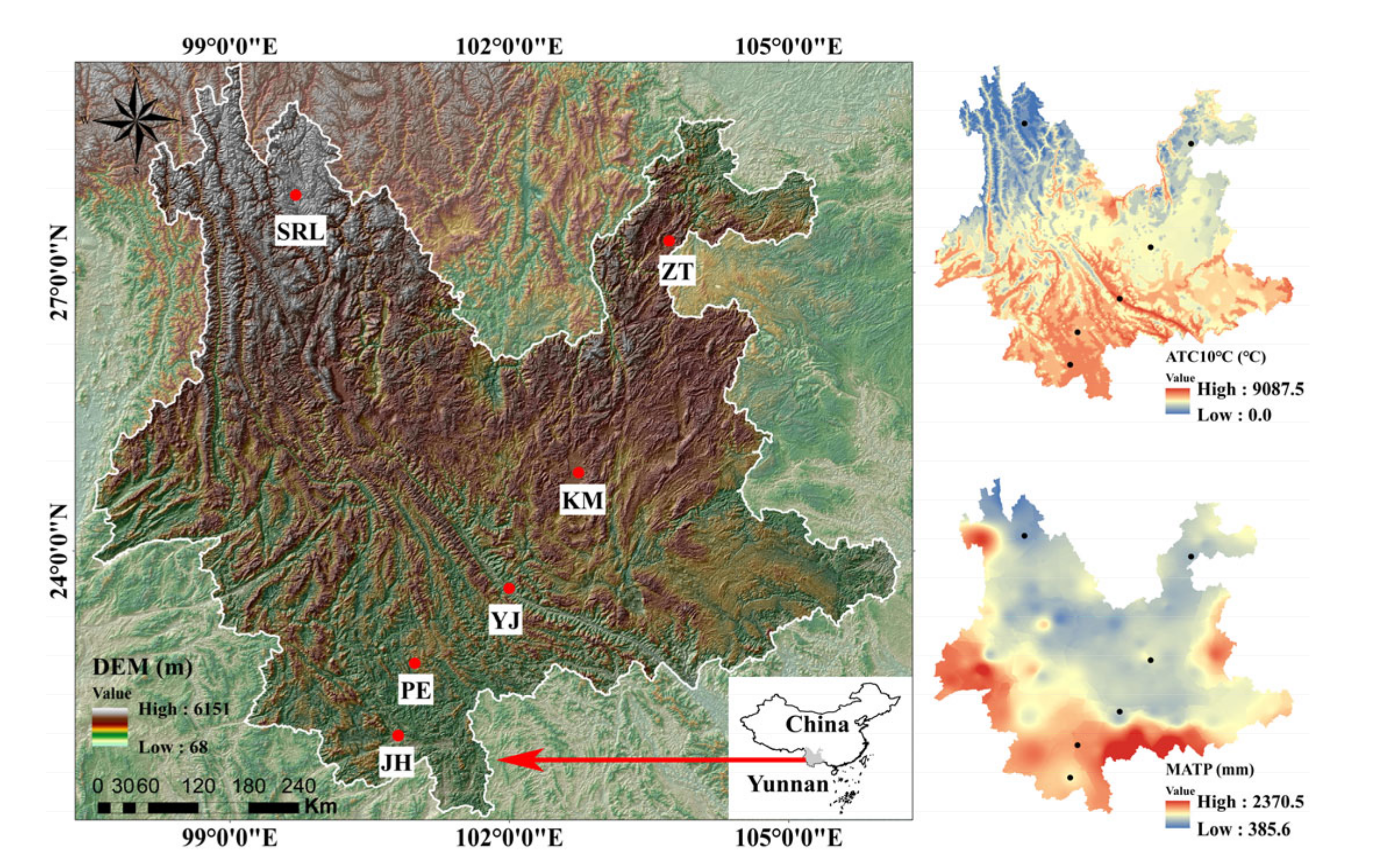
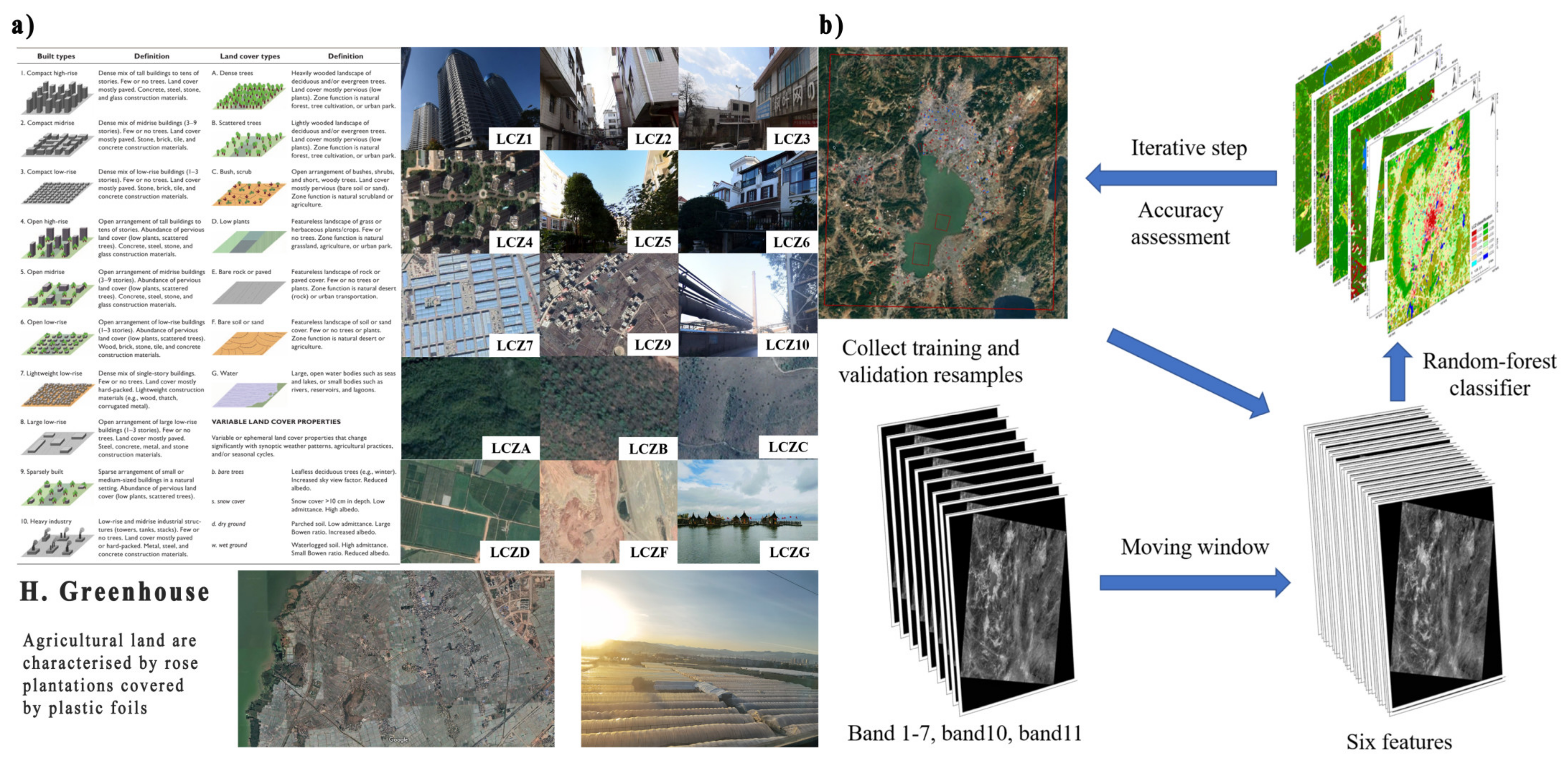

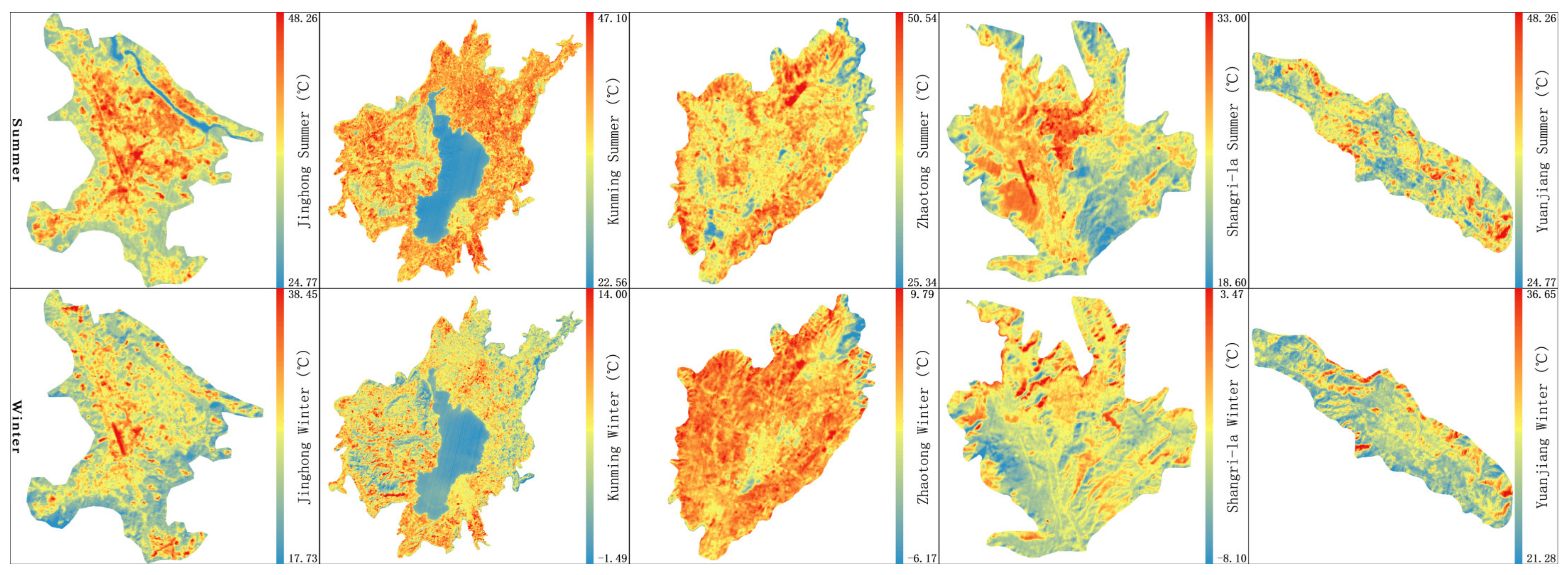
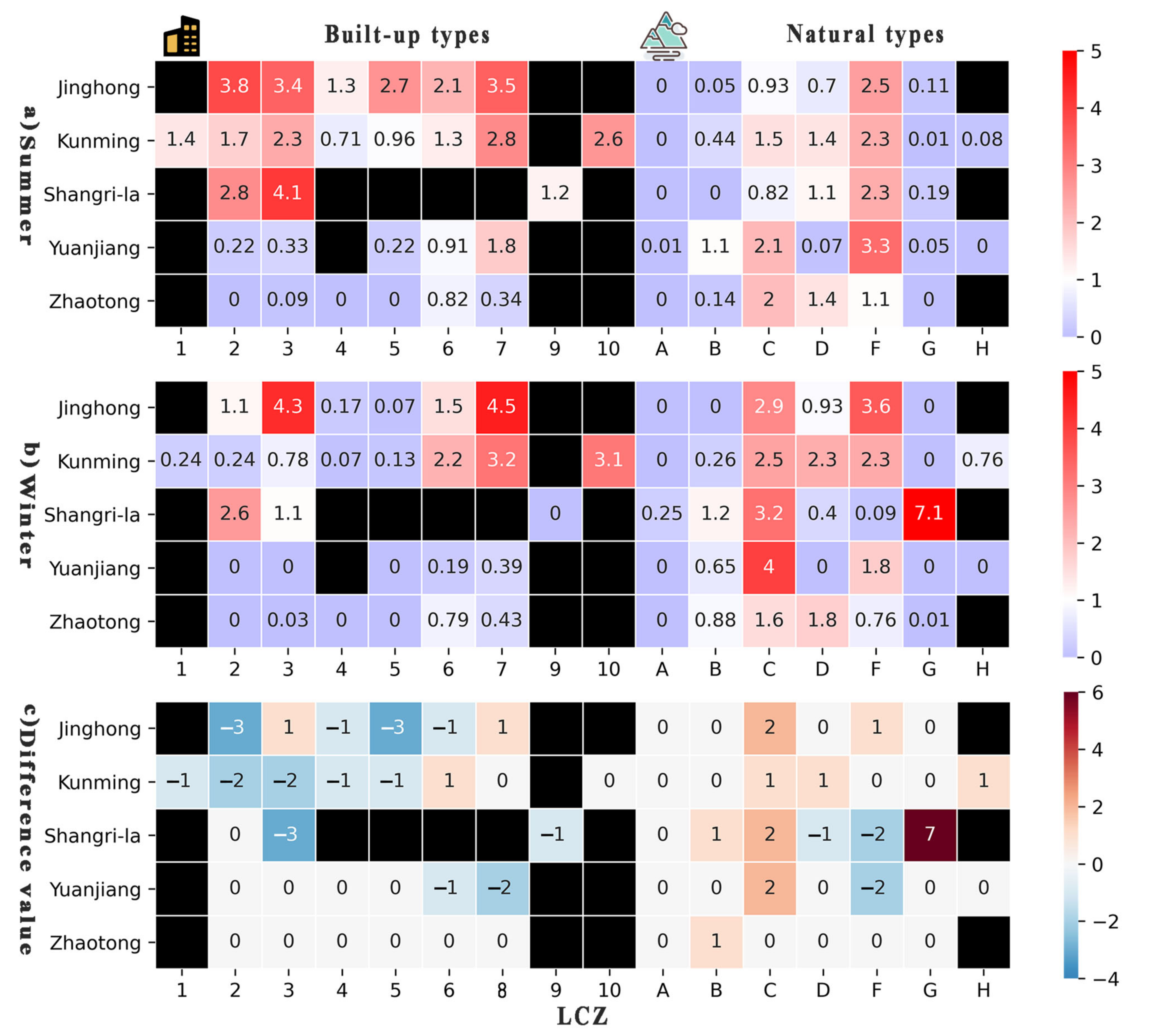
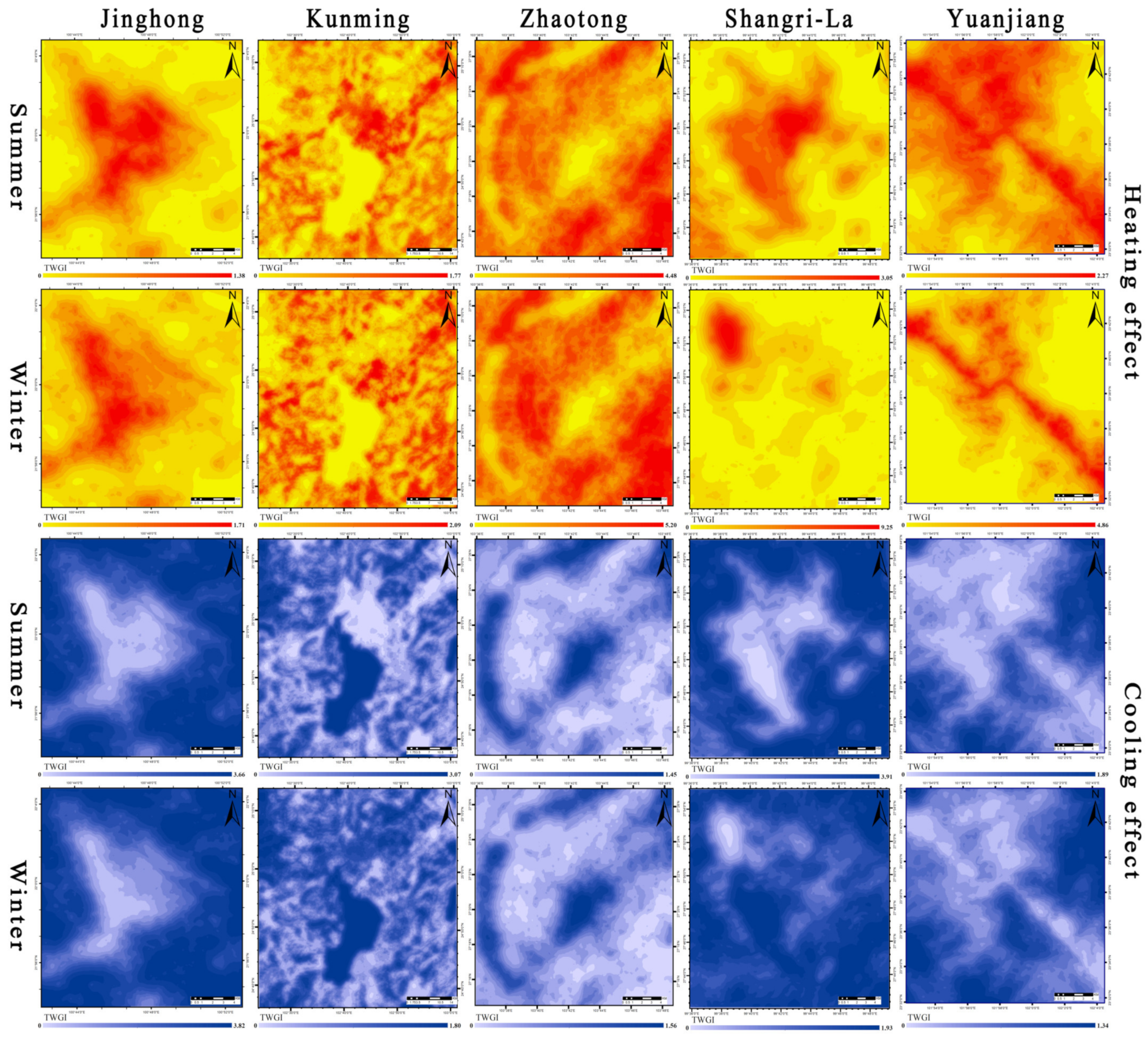
| City | Days of ATC10 °C | ATC10 °C (°C) | Altitude (m) | MATP 1 (mm) | Climate Zone |
|---|---|---|---|---|---|
| Yuanjiang | >218 | 8844.2 | <500 | 864.4 | Tropic (Arid) |
| Jinghong | >218 | 8373.6 | 500–3000 | 1198.0 | Tropic |
| Kunming | >218 | 5558.6 | 500–3000 | 1002.2 | Mid-subtropic |
| Zhaotong | >218 | 3914.8 | ≥3000 | 742.8 | Temperate zone |
| Shangri-La | >140 | 1916.0 | ≥3000 | 617.0 | Alpine zone |
| LCZ | Jinghong | Kunming | Zhaotong | Shangri-La | Yuanjiang | |||||
|---|---|---|---|---|---|---|---|---|---|---|
| Summer | Winter | Summer | Winter | Summer | Winter | Summer | Winter | Summer | Winter | |
| LCZ1 (compact high-rise) | NA | NA | 40.2 | 5.7 | NA | NA | NA | NA | NA | NA |
| LCZ2 (compact mid-rise) | 40.8 1 | 26.6 | 40.7 | 6.3 | 40.4 | 0.01 | 27.9 1 | −1.4 1 | 44.5 | 27.1 |
| LCZ3 (compact low-rise) | 40.6 1 | 27.6 1 | 41.3 | 7.1 | 41.2 | 1.9 | 29.0 1 | −1.8 | 43.7 | 27.4 |
| LCZ4 (open high-rise) | 37.3 | 24.9 | 38.9 | 4.9 | 38.2 | −1.1 2 | NA | NA | NA | NA |
| LCZ5 (open mid-rise) | 39.0 | 25.1 | 39.5 | 5.9 | 39.1 | −0.7 | NA | NA | 44.3 | 27.1 |
| LCZ6 (open low-rise) | 38.6 | 26.3 | 40.0 | 7.9 | 41.8 | 3.3 | NA | NA | 44.1 | 27.0 |
| LCZ8 (large low-rise) | 41.0 1 | 28.0 1 | 42.6 1 | 8.9 1 | 41.3 | 2.3 | NA | NA | 45.6 1 | 28.4 1 |
| LCZ9 (sparsely built) | NA | NA | NA | NA | NA | NA | 26.5 | −3.7 | NA | NA |
| LCZ10 (heavy industry) | NA | NA | 42.4 1 | 8.9 1 | NA | NA | NA | NA | NA | NA |
| LCZA (dense trees) | 33.3 2 | 23.2 2 | 33.2 2 | 2.0 2 | 32.8 2 | −5.0 2 | 21.2 2 | −3.8 2 | 40.9 2 | 25.0 2 |
| LCZB (scattered trees) | 35.0 | 24.1 2 | 37.6 | 5.5 | 38.4 | 1.9 | 23.8 2 | −2.6 | 43.9 | 26.8 |
| LCZC (bush, scrub) | 37.0 | 26.9 | 40.1 | 8.1 1 | 43.3 1 | 4.1 1 | 26.2 | −1.4 1 | 45.2 1 | 29.2 1 |
| LCZD (low plants) | 36.8 | 25.8 | 40.0 | 8.1 1 | 42.0 1 | 4.2 1 | 26.5 | −3.3 | 41.6 | 26.8 2 |
| LCZF (Bare soil or sand) | 39.0 | 27.4 1 | 41.7 1 | 8.1 1 | 42.5 1 | 3.4 1 | 27.0 1 | −4.3 2 | 46.3 1 | 29.1 1 |
| LCZG (water) | 32.3 2 | 24.3 | 24.4 2 | 0.3 2 | 34.3 2 | −0.3 | 23.8 2 | 1.8 1 | 41.6 | 26.8 2 |
| LCZH (greenhouse) | NA | NA | 36.5 | 7.2 | NA | NA | NA | NA | 41.4 2 | 26.8 2 |
| City | Thermal Contribution | Coefficient (Summer) | Coefficient (Winter) | Seasonal Change Gradient |
|---|---|---|---|---|
| Jinghong | Heating | 13.27 | 9.12 | −0.31 |
| Cooling | −1.81 | −1.99 | 0.10 | |
| Yuanjiang | Heating | 1.51 | 0.52 | −0.66 |
| Cooling | −12.73 | −4.30 | −0.66 | |
| Kunming | Heating | 7.89 | 5.46 | −0.31 |
| Cooling | −12.73 | −4.72 | −0.63 | |
| Zhaotong | Heating | 0.28 | 0.38 | 0.36 |
| Cooling | −0.19 | −0.42 | 1.21 | |
| Shangri-La | Heating | 8.58 | 2.39 | −0.72 |
| Cooling | −0.92 | −0.57 | −0.38 |
Publisher’s Note: MDPI stays neutral with regard to jurisdictional claims in published maps and institutional affiliations. |
© 2022 by the authors. Licensee MDPI, Basel, Switzerland. This article is an open access article distributed under the terms and conditions of the Creative Commons Attribution (CC BY) license (https://creativecommons.org/licenses/by/4.0/).
Share and Cite
Li, N.; Wang, B.; Yao, Y.; Chen, L.; Zhang, Z. Thermal Contribution of the Local Climate Zone and Its Spatial Distribution Effect on Land Surface Temperature in Different Macroclimate Cities. Remote Sens. 2022, 14, 4029. https://doi.org/10.3390/rs14164029
Li N, Wang B, Yao Y, Chen L, Zhang Z. Thermal Contribution of the Local Climate Zone and Its Spatial Distribution Effect on Land Surface Temperature in Different Macroclimate Cities. Remote Sensing. 2022; 14(16):4029. https://doi.org/10.3390/rs14164029
Chicago/Turabian StyleLi, Ninglv, Bin Wang, Yang Yao, Liding Chen, and Zhiming Zhang. 2022. "Thermal Contribution of the Local Climate Zone and Its Spatial Distribution Effect on Land Surface Temperature in Different Macroclimate Cities" Remote Sensing 14, no. 16: 4029. https://doi.org/10.3390/rs14164029
APA StyleLi, N., Wang, B., Yao, Y., Chen, L., & Zhang, Z. (2022). Thermal Contribution of the Local Climate Zone and Its Spatial Distribution Effect on Land Surface Temperature in Different Macroclimate Cities. Remote Sensing, 14(16), 4029. https://doi.org/10.3390/rs14164029







